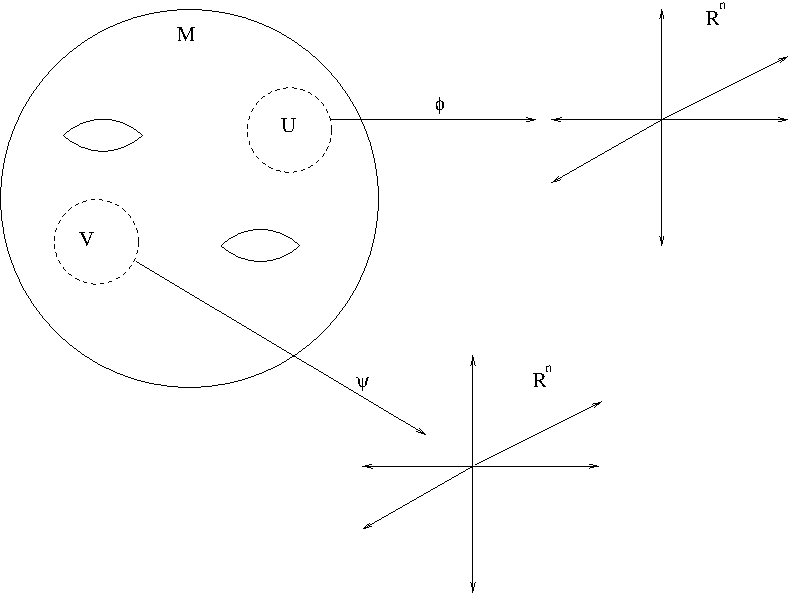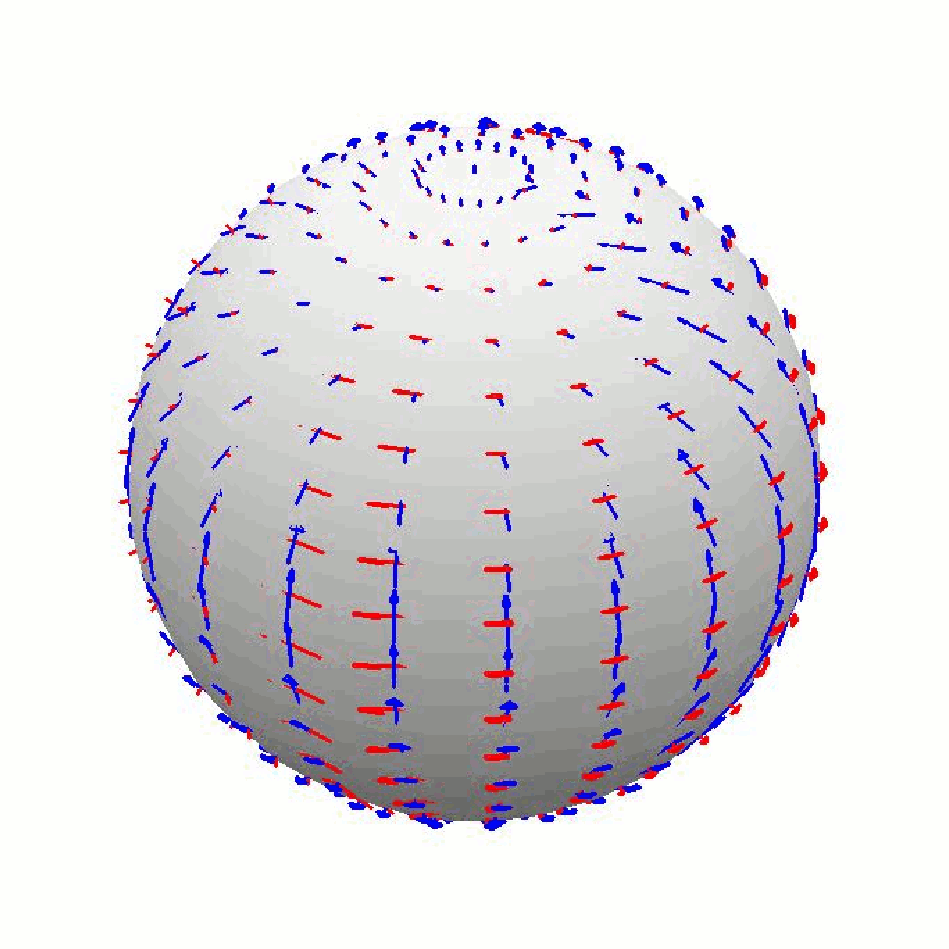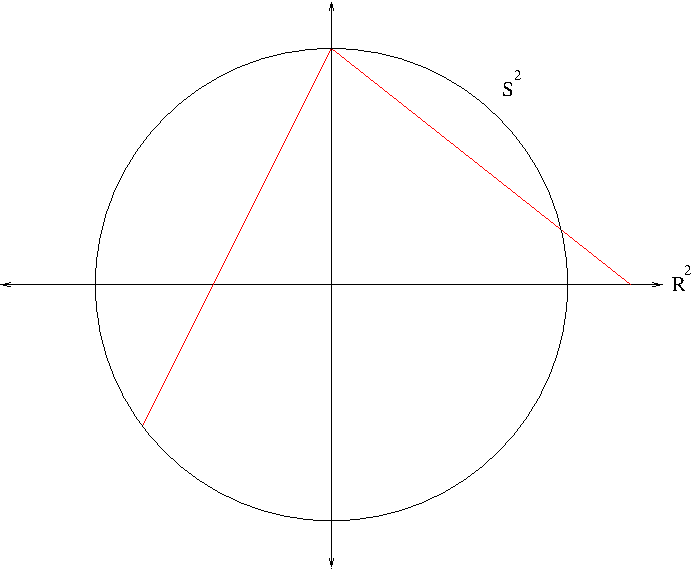This note is intended particularly for students of physics who have never had any prior encounter with differential geometry. Hence, I try to maintain mathematical rigor and technicalities at a minimum when I discuss differential geometric concepts, instead mostly use hand-waving and rudimentary arguments with emphases on physical ideas and intuition.
The notion of (pseudo-)Riemannian manifolds plays an important role in studying general relativity. But first, what is a manifold? A manifold is, very roughly speaking, a space which locally looks like our space (Euclidean space). In other words, for any point $p$ in a manifold $M$ there exists a neighborhood (called a coordinate neighborhood) $U$ of $p$ such that $U\cong\mathbb{R}^n$. Here $\cong$ means they are homeomorphic i.e. topologically indistinguishable. Such a property is said to be locally Euclidean and a space which is locally $\mathbb{R}^n$ is called an $n$-dimensional manifold. Actually being locally Euclidean is not the only condition for a space to be a manifold but that is the most important property of a manifold for physicists.

Figure 1 shows a manifold $M$, two coordinate neighborhood $U$ and $V$ with homeomorphisms $\phi$ and $\psi$, respectively. Why do we need manifolds by the way? In order to do physics, we need coordinates. Without coordinates we can’t write equations of motion. Unfortunately, even for a simple familiar space there is no guarantee that there will be a global coordinate system. Here is an example.
Example. The points $(x,y,z)$ on the 2-sphere $S^2$ are represented in terms of the spherical coordinates $(\theta,\phi)$ as $$x=\sin\phi\cos\theta,\ y=\sin\phi\sin\theta,\ z=\cos\phi,\ 0\leq\phi\leq\pi,\ 0\leq\theta\leq 2\pi$$ Using the chain rule, we can write the standard basis $\frac{\partial}{\partial\theta}$, $\frac{\partial}{\partial\phi}$ for the tangent space $T_\ast S^2$ in spherical coordinates in terms of the standard basis $\frac{\partial}{\partial x}$, $\frac{\partial}{\partial y}$, $\frac{\partial}{\partial y}$ in rectangular coordinates as \begin{align*}\frac{\partial}{\partial\theta}&=-\sin\phi\sin\theta\frac{\partial}{\partial x}+\sin\phi\cos\theta\frac{\partial}{\partial y}\\\frac{\partial}{\partial\phi}&=\cos\phi\cos\theta\frac{\partial}{\partial x}+\cos\phi\sin\theta\frac{\partial}{\partial y}-\sin\phi\frac{\partial}{\partial z}\end{align*} This frame field is not globally defined on $S^2$ because $\frac{\partial}{\partial\theta}=0$ at $\phi=0,\pi$ i.e. at the north pole $N=(0,0,1)$ and at the south pole $S=(0,0,-1)$ as also seen in Figure 2.

The 2-sphere $S^2$ is covered by two coordinates neighborhoods $U=S^2\setminus{N}$ and $V=S^2\setminus{S}$, each of which is identified with $\mathbb{R}^2$, the Euclidean plane via the stereographic projection. Figure 3 shows the stereographic projection from the north pole $N$, which is a one-to-one correspondence from $U$ to $\mathbb{R}^2$.

A global coordinate system exists in the flat Euclidean space (or a flat pseudo-Euclidean space including Minkowski spacetime), however general relativity has taught us that a physical space is not necessarily a flat space (vaccum spacetime). This is where a manifold comes in. A manifold guarantees the existence coordinate system at least locally and for most cases that is good enough to do physics in particular we write physical equations in a coordinate independent way, so that if a physical equation holds in on coordinate neighborhood, it should also hold in another coordinate neighborhood in the same way.
We would be needing more than topological manifolds to do physics. For an obvious reason we need differentiable manifolds. I am not going to delve into this except for just saying that a differentiable manifold is a manifold on which the differentiability of functions and vector fields can be defined and also to which tangent space at each point can be considered. (If we can’t differentiate fields, we cannot do physics.) In addition, we need Riemannian manifolds. A Riemannian manifold is a differentiable manifold with a Riemannian metric. So what is a Riemannian metric? A Riemannian metric $g$ is a positive definite bilinear symmetric form $g_p: T_pM\times T_pM\longrightarrow\mathbb{R}$, which induces a positive definite inner product on each tangent space $T_pM$. In a coordinate neighborhood, the metric $g$ can be locally given by \begin{equation}\label{eq:metric}g=g_{ij}dx^i\otimes dx^j\end{equation}Here we are using the Einstein’s summation convention. The $n\times n$ matrix $(g_{ij})$ is called a metric tensor and physicists often simply write $g_{ij}$ for the metric tensor, not for the component. Since $g_{ij}$ is a symmetric tensor, it can be diagonalized. Since the metric is preserved under diagonalization (which amounts to a change of coordinates), without loss of generality we may assume that $g_{ij}=0$ if $i\ne j$ so that the metric tensor \eqref{eq:metric} is written as\begin{equation}\label{eq:metric2}g=g_{ii}dx^i\otimes dx^i\end{equation}Let the dimension of $M$ be $n$. Then each tangent space $T_pM$ is an $n$-dimensional vector space with the canonical orthonormal basis $\left(\frac{\partial}{\partial x^1}\right)_p,\cdots,\left(\frac{\partial}{\partial x^n}\right)_p$. Thus any tangent vector $v\in T_pM$ can be written as $$v=v^j\left(\frac{\partial}{\partial x^j}\right)_p$$ The differential 1-forms $d^i$ are the duals of $\frac{\partial}{\partial x^i}$, respectively. $$dx^i\left(\frac{\partial}{\partial x^j}\right)=\delta_{ij}$$ and hence $$dx^i(v)=v^i$$ For any two tangent vectors $v,w\in T_pM$ using \eqref{eq:metric2} we obtain \begin{equation}\label{eq:metric3}g(v,w)=g_{ii}dx^i\otimes dx^i(v,w)=g_{ii}dx^i(v)dx^i(w)=g_{ii}v^iw^i\end{equation}\eqref{eq:metric3} shows how the metric $g$ induces an inner product on each tangent space $T_pM$. In doing physics, in particular general relativity, the physical space is often a pseudo-Riemannian manifold rather than a Riemannian manifold. A pseudo-Riemannian manifold is equipped with a pseudo-Riemannian metric which is an indefinite symmetric bilinear form. So the induced inner product is indefinite. A good example is the Minkowski spacetime $\mathbb{R}^{3+1}$ which is $\mathbb{R}^4$ with the Minkowski metric or the Lorentz-Minkowski metric \begin{equation}\label{eq:minkowski}g=-dt^2+dx^2+dy^2+dz^2\end{equation} The Minkowski metric \eqref{eq:minkowski} induces the inner product on $\mathbb{R}^{3+1}$ (The Minkowski spacetime has a single coordinate neighborhood $\mathbb{R}^{3+1}$ itself and every tangent space $T_p\mathbb{R}^{3+1}$ is isomorphic to $\mathbb{R}^{3+1}$, hence $\mathbb{R}^{3+1}$ is a manifold and at the same time it is also a vector space.) $$\langle v,w\rangle=-v^0w^0+v^1w^1+v^2w^2+v^3w^3$$ where $v=(v^0,v^1,v^2,v^3)$ and $w=(w^0,w^1,w^2,w^3)$ are four-vectors in $\mathbb{R}^{3+1}$.
In conclusion, I would like to emphasize that the metric tensor $g_{ij}$ is the most important ingredient of a Riemannian or a pseudo-Riemannian manifold. You can literally find out everything about the geometry of a Riemannian or a pseudo-Riemannian manifold with the metric tensor. With the metric tensor, you can also find out about what gravity does when there is matter (the source of gravity) present in the manifold.
